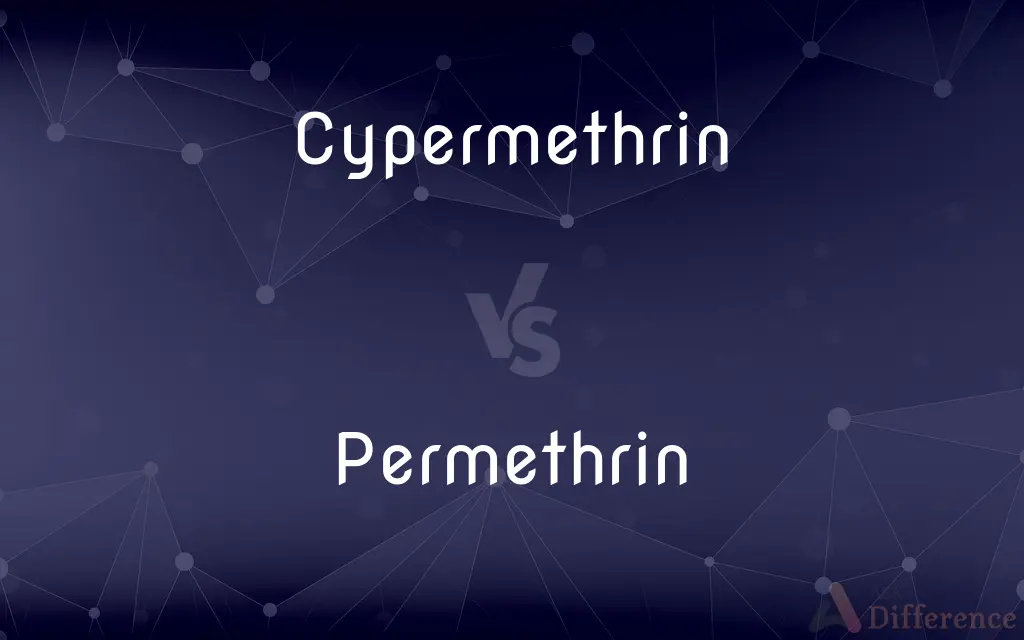Cypermethrin vs. Permethrin — What's the Difference?
By Tayyaba Rehman — Updated on October 25, 2023
Cypermethrin is a synthetic pyrethroid insecticide, while Permethrin is another synthetic pyrethroid primarily used against pests and vectors.

Difference Between Cypermethrin and Permethrin
Table of Contents
ADVERTISEMENT
Key Differences
Cypermethrin is a type of synthetic pyrethroid insecticide commonly utilized in agriculture to protect crops. Permethrin, while also a synthetic pyrethroid, is widely recognized for its role in public health, especially in combating disease vectors.
In terms of formulation, Cypermethrin is often found in sprays, dusts, and emulsifiable concentrates for diverse applications. Permethrin, on the other hand, has a broader use in products, from clothing treatments to creams and lotions for direct skin application.
Safety-wise, both Cypermethrin and Permethrin are generally safe for humans when used as directed. However, they can be toxic to aquatic life and beneficial insects, with Cypermethrin having a slightly higher toxicity profile.
One significant difference is the area of application. Cypermethrin is predominantly used in the agricultural sector to protect a variety of crops. In contrast, Permethrin is more associated with personal protective measures, especially against ticks and mosquitoes.
Both Cypermethrin and Permethrin function by targeting the nervous systems of insects. However, while they have similar mechanisms of action, their specific uses and formulations can differ significantly based on their target pests and application areas.
ADVERTISEMENT
Comparison Chart
Primary Use
Agricultural insecticide
Personal protective measures & public health
Formulation
Sprays, dusts, emulsifiable concentrates
Creams, lotions, sprays, treated clothing
Toxicity
Higher toxicity to aquatic life
Lesser toxicity to aquatic life
Target pests
Broad spectrum, crop pests
Disease vectors like ticks and mosquitoes
Chemical Class
Synthetic pyrethroid
Synthetic pyrethroid
Compare with Definitions
Cypermethrin
Cypermethrin is a synthetic pyrethroid insecticide.
Farmers use Cypermethrin to protect their crops from pests.
Permethrin
Permethrin is a synthetic pyrethroid used against pests and vectors.
To prevent mosquito bites, campers treated their tents with Permethrin.
Cypermethrin
Cypermethrin is commonly used in agriculture.
To prevent a locust invasion, vast farmlands were sprayed with Cypermethrin.
Permethrin
Permethrin works by attacking the nervous system of pests.
Ticks exposed to Permethrin become paralyzed and eventually die.
Cypermethrin
Cypermethrin targets the nervous system of insects.
The effectiveness of Cypermethrin lies in its ability to disrupt insect neural functions.
Permethrin
Permethrin finds applications in lotions, sprays, and clothing treatments.
Before hiking, John applied a Permethrin spray to his boots and pants.
Cypermethrin
Cypermethrin has a range of formulations including sprays and dusts.
The garden store offers Cypermethrin in both liquid spray and dust form.
Permethrin
Permethrin is used in public health initiatives.
Public health agencies distribute Permethrin-treated bed nets to combat malaria.
Cypermethrin
Cypermethrin can be toxic to beneficial insects and aquatic life.
Care needs to be taken when using Cypermethrin near ponds to protect fish.
Permethrin
Permethrin is safe for humans when used as directed.
The Permethrin cream was effective against lice and safe for the child to use.
Cypermethrin
Cypermethrin (CP) is a synthetic pyrethroid used as an insecticide in large-scale commercial agricultural applications as well as in consumer products for domestic purposes. It behaves as a fast-acting neurotoxin in insects.
Permethrin
Permethrin, sold under the brand name Nix among others, is a medication and insecticide. As a medication, it is used to treat scabies and lice.
Cypermethrin
A pyrethroid insecticide and acaricide.
Permethrin
A synthetic pyrethroid, C21H20Cl2O3, used as an agricultural, industrial, and residential insecticide, to treat scabies and head lice in humans, and to control fleas and ticks in dogs.
Permethrin
A synthetic insecticide, C21H20Cl2O3, used to treat head lice, nits, scabies, and in flea collars.
Common Curiosities
What is the main purpose of Cypermethrin?
Cypermethrin is primarily used as an agricultural insecticide to protect crops.
Is Cypermethrin safe for home gardens?
Yes, when used as directed, but care should be taken to avoid harm to beneficial insects and aquatic life.
Can Permethrin be applied directly to the skin?
Yes, there are Permethrin formulations like creams and lotions specifically designed for direct skin application.
How does Permethrin benefit public health?
Permethrin is used in personal protective measures and products to combat disease vectors like mosquitoes and ticks.
Is Permethrin used in clothing treatments?
Yes, Permethrin is often applied to clothing to repel and kill disease vectors like ticks and mosquitoes.
Are both Cypermethrin and Permethrin synthetic pyrethroids?
Yes, both Cypermethrin and Permethrin belong to the synthetic pyrethroid class of chemicals.
How do Cypermethrin and Permethrin differ in their applications?
Cypermethrin is predominantly used for crop protection, while Permethrin is more for personal protection and public health.
Are there environmental concerns related to Cypermethrin use?
Yes, Cypermethrin can be toxic to aquatic organisms and beneficial insects if misused.
Can both compounds be used indoors?
While specific formulations might be suitable for indoor use, it's essential to follow product labels for both Cypermethrin and Permethrin.
How do both Cypermethrin and Permethrin work against pests?
Both compounds target the nervous system of insects, leading to their paralysis and death.
Do Cypermethrin and Permethrin have any health effects on humans?
Generally, when used as directed, they're safe, but misuse or overexposure can lead to health issues. Always follow label instructions.
Are Cypermethrin and Permethrin harmful to pets?
While generally safe, it's crucial to use them as directed and ensure pets aren't directly exposed to large amounts.
Are there resistance issues with pests and these compounds?
Some pests can develop resistance to Cypermethrin and Permethrin, emphasizing the importance of integrated pest management.
Can I use Cypermethrin and Permethrin interchangeably?
While they have similar properties, they're designed for different purposes, so it's essential to follow product labels.
How should products containing these chemicals be stored?
Both Cypermethrin and Permethrin products should be stored in cool, dry places away from children and pets.
Share Your Discovery

Previous Comparison
Cream vs. Ivory
Next Comparison
Either vs. BothAuthor Spotlight
Written by
Tayyaba RehmanTayyaba Rehman is a distinguished writer, currently serving as a primary contributor to askdifference.com. As a researcher in semantics and etymology, Tayyaba's passion for the complexity of languages and their distinctions has found a perfect home on the platform. Tayyaba delves into the intricacies of language, distinguishing between commonly confused words and phrases, thereby providing clarity for readers worldwide.
















































